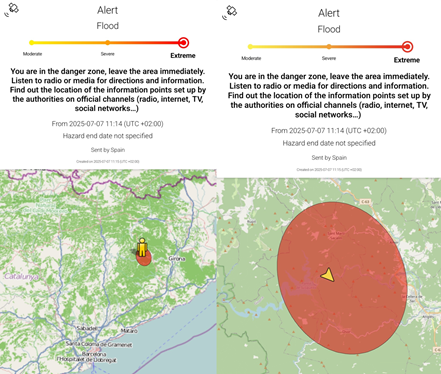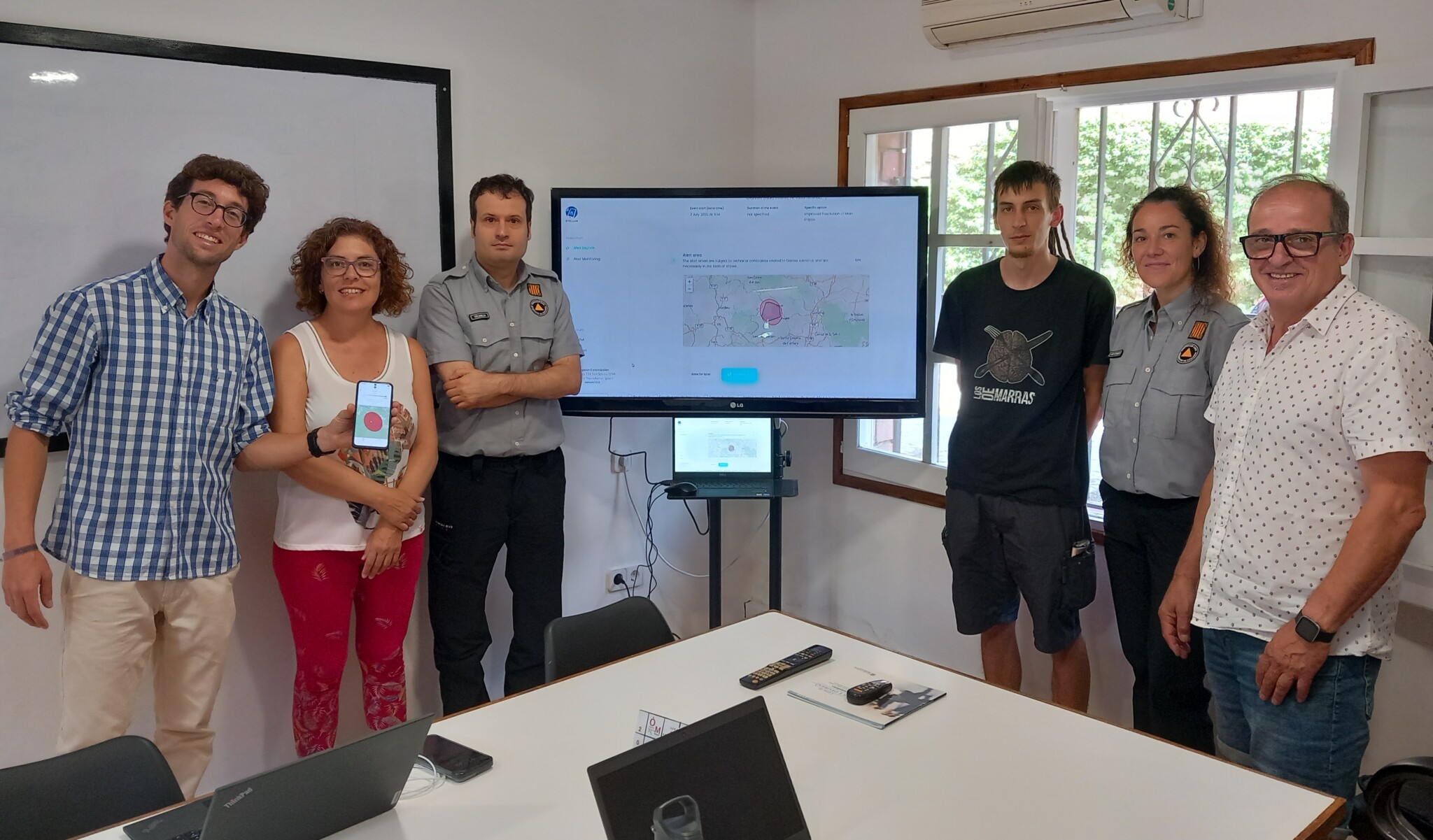Pilot test of Civil Protection alert delivery via satellite to mobile phones in the municipality of Osor (La Selva)
- The aim of the test is to validate the capabilities of the future European alert delivery service to mobile phones via Galileo satellites to warn the population in case of an emergency
- The EWSS service, currently in a testing phase, will complement existing alert systems such as Es-Alert and strengthen civil protection across Europe
- The test, promoted by the Secretariat for Digital Policies of the Ministry of Business and Labour within the framework of the NewSpace Strategy of Catalonia, was developed by the Civil Protection of the Government of Catalonia and the Institute of Space Studies of Catalonia (IEEC)

On 7 July, the municipality of Osor (La Selva) hosted a pilot test of satellite-based alert delivery to mobile phones. The initiative was promoted by the Secretariat for Digital Policies of the Department of Business and Labour within the framework of Catalonia’s NewSpace Strategy, and was carried out by the Government of Catalonia’s Civil Protection (Ministry of Home Affairs and Public Safety) and the Institute of Space Studies of Catalonia (IEEC). The aim of the test was to demonstrate the capabilities of delivering alerts to the population’s mobile phones via Galileo satellites in an area without mobile network coverage, in order to assess the use of alternative systems to warn the public in the event of serious emergencies.
This pilot test in Osor follows a previous demonstration held last February at the World Trade Center in Barcelona as part of the workshop Satellite-based Services for Disaster Risk Management. That event showcased the future Galileo Emergency Warning Satellite Service (EWSS), which is currently in a testing phase. EWSS is a technological service designed to support and complement existing civil protection systems for mass alert delivery to the public in the event of emergencies, such as Es-Alert, thereby enhancing current capabilities. “Emergency management is a critical field where space technologies can provide significant added value,” stated Maria Galindo, Secretary for Digital Policies, who added that “the Government is working to position Catalonia as a benchmark in the application of innovative space technologies in the service of society.”
Satellite-based communication through the Galileo system will represent a paradigm shift in the field of civil protection across Europe. Unlike current alerts, which rely on terrestrial telephone networks, the EWSS will transmit information, alerts, and safety instructions to mobile phones — even those located in areas without coverage — and will remain operational during disasters that may affect ground infrastructure. This will significantly enhance existing emergency notification capabilities thanks to the global coverage provided by satellites.
This new service, developed and tested by the European Commission together with the European Union Agency for the Space Programme (EUSPA), will be made available to Civil Protection authorities across Europe. In this case, the IEEC, within the framework of the NewSpace Strategy promoted by the Government of Catalonia, has acted as a liaison between EUSPA and the Directorate General of Civil Protection of the Generalitat de Catalunya. Josep Colomé, Director of the Area for the Promotion of the Space Sector of Catalonia (APEC) at the IEEC, emphasized that “the demonstration showcases the effort to improve services for citizens and industry through satellite-provided solutions and the use of the data these satellites provide. This goal is driven in collaboration with international organizations such as EUSPA.”
Flood risk alert drill in Osor
The EWSS demonstration in Osor simulated a flood risk scenario in the drill area. The alert was issued from the town of Osor and reached the Galileo Search and Rescue Service Center, located at the CNES (French Space Agency) facilities in Toulouse, Occitanie, which is responsible for transmitting it to the Galileo satellites. These satellites, upon passing over the area of interest, broadcasted the message to mobile phones located within the emergency zone.
The service transmitted the alert messages within seconds to devices located in the Osor area, which at that time were in a location without mobile coverage. Moreover, thanks to Galileo’s precision and the service’s configuration, users were able to accurately view the affected area.

“This initiative reinforces the commitment of the Generalitat’s Civil Protection to technological innovation and the continuous improvement of population alert systems, contributing to a more efficient and coordinated response in emergency situations,” said Cristina Vicente, Head of Operations at Civil Protection.
The exercise was carried out in the presence of the mayor and town councilors, representatives of Civil Protection and the Catalonia Operational Coordination Center (CECAT) as the authorities responsible for issuing the alert, and members of the IEEC, the entity that will provide support to the service throughout the entire testing phase of the system.
Satellite Technologies for Emergency Management
The pilot test conducted in Osor is a continuation of the demonstration of satellite-based mobile alert sending via the EWSS service, which took place last February at the World Trade Center in Barcelona during the event ‘Satellite-based Services for Disaster Risk Management,’ focused on the use of satellite technologies for disaster risk management. The event was organized by the IEEC and the Secretariat of Digital Policies within the framework of Catalonia’s NewSpace Strategy, in collaboration with the Spanish Space Agency (AEE) and the Spanish Ministries of Science, Innovation and Universities, and Defense.
At the event, experts in space and emergency technologies, along with representatives from public administrations, research institutions, and the private sector, explored and highlighted the potential of satellite applications to enhance the response capacity and risk reduction capabilities of emergency and security services in the face of increasingly frequent extreme events such as floods, wildfires, and earthquakes.
The event featured two live demonstrations to showcase the practical advantages of space technologies in emergency management and to strengthen collaboration between emergency services and satellite-based solution providers: a maritime rescue drill in the Port of Barcelona and a demonstration of alert delivery to the public’s mobile phones via Galileo satellites, using the same system that was later tested in Osor.
Contacts
IEEC Communication Office
Castelldefels, Barcelona
E-mail: comunicacio@ieec.cat
About the IEEC
The Institute of Space Studies of Catalonia (IEEC — Institut d’Estudis Espacials de Catalunya) promotes and coordinates space research and technology development in Catalonia for the benefit of society. IEEC fosters collaborations both locally and worldwide and is an efficient agent of knowledge, innovation and technology transfer. As a result of more than 25 years of high-quality research, done in collaboration with major international organisations, IEEC ranks among the best international research centres, focusing on areas such as: astrophysics, cosmology, planetary science, and Earth Observation. IEEC’s engineering division develops instrumentation for ground- and space-based projects, and has extensive experience in working with private or public organisations from the aerospace and other innovation sectors.
The IEEC is a non-profit public sector foundation that was established in February 1996. It has a Board of Trustees composed of the Generalitat de Catalunya, Universitat de Barcelona (UB), Universitat Autònoma de Barcelona (UAB), Universitat Politècnica de Catalunya · BarcelonaTech (UPC), and the Spanish Research Council (CSIC). The IEEC is also a CERCA centre.
